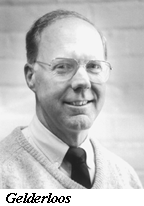The University Record, January 14, 1997
U-M-Dearbron receives $100,000 EPA grant
The U-M-Dearborn has received a $100,000 grant from the Environmental Protection Agency (EPA) to host an institute for teachers from southeast Michigan next summer. Up to 40 teachers will participate in the 15-day program next July.
 “This region is an especially appropriate location for an environmental education institute,” says Orin Gelderloos, director of the campus’ Environmental Studies Program. He noted that, as the location for mass production for more than a century, southeastern Michigan has accumulated significant historic pollution.
“This region is an especially appropriate location for an environmental education institute,” says Orin Gelderloos, director of the campus’ Environmental Studies Program. He noted that, as the location for mass production for more than a century, southeastern Michigan has accumulated significant historic pollution.
“First, we have hundreds of contaminated sites which pollute the soil and ground water,” Gelderloos says. “Second, urban sprawl is consuming vast amounts of open space as citizens avoid the `brownfields’ in the city centers. The spread of urbanization is likely to counteract the improvements which have been made in air and water quality over the past decades.”
Faculty and staff at U-M-Dearborn have provided environmental education to teachers in southeast Michigan since the early 1970s, with significant funding over the years from the National Science Foundation.
“The interactions among teachers from throughout the Detroit metropolitan area have proven to be invaluable for establishing cross-district and cross-cultural linkages,” Gelderloos says. “In fact, the model of environmental education used in our most recent program was deemed so successful by the NSF that it chose to disseminate this model nationally.”
In addition, the U-M-Dearborn campus itself is a unique environmental resource in the metropolitan area. One- third of the campus, more than 70 acres, is designated an environmental/historical preserve, adjacent to the Rouge River and the river’s flood plain.
“This area provides a rich diversity of flora and fauna in forest, aquatic and field habitats,” Gelderloos says. Recently the Rouge River Bird Observatory was established on campus to study the use of urban areas as stop-over sites for migrating species.
Thousands of schoolchildren and teachers take part in programs in the U-M-Dearborn’s natural areas each year, and more than 30,000 visitors walk through the area each year. “Clearly, U-M-Dearborn has an enviable record in community interaction and public service,” Gelderloos says.
U-M-Dearborn officials are still developing a selection process for teachers interested in the program. Preference will be given to teachers who apply as teams from a single school since “we have found that the greatest impact for making a change in the schools is to have teams of teachers from different disciplines, such as social studies, natural sciences, mathematics, language arts and humanities, work together in a program,” Gelderloos says.
The EPA-funded program, which will include hands-on experiences in the field and workshops on curriculum development, will focus on the Rouge River watershed, which includes 47 governmental units; a great diversity of people, from some of the wealthiest in the world to some of the poorest; and rural, suburban and urban areas.
“A watershed model brings global environmental issues and problems to the local level; in many respects a watershed is a microcosm of the planet and developing solutions to environmental problems in a watershed is similar to solving environmental problems in the United Nations,” Gelderloos said.
“By using a watershed approach to environmental education, not only will we be able to bring teachers from a variety of academic disciplines together in a real-world, interdisciplinary problem-solving situation, but also we will be able to bring people from a variety of socio-economic situations together in a common cause which will improve the quality of life for all citizens,” he says.
For more information or for application forms, contact Gelderloos, 593-5339, or send e-mail to [email protected].

